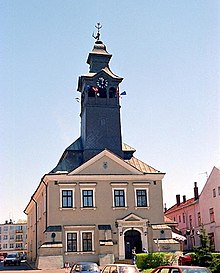Przeworsk
| Przeworsk | ||
|---|---|---|

|
|
|
| Basic data | ||
| State : | Poland | |
| Voivodeship : | Subcarpathian | |
| Powiat : | Przeworsk | |
| Area : | 21.98 km² | |
| Geographic location : | 50 ° 4 ′ N , 22 ° 30 ′ E | |
| Height : | 200 m npm | |
| Residents : | 15,356 (Jun. 30, 2019) |
|
| Postal code : | 37-200 | |
| License plate : | RPZ | |
| Economy and Transport | ||
| Street : | Krakow - Lviv | |
| Rail route : |
Krakow - Lemberg Lublin - Przeworsk |
|
| Przeworsk – Dynów | ||
| Next international airport : | Rzeszów-Jasionka | |
| Gmina | ||
| Gminatype: | Borough | |
| Residents: | 15,356 (Jun. 30, 2019) |
|
| Community number ( GUS ): | 1814011 | |
| Administration (as of 2007) | ||
| Mayor : | Janusz Magoń | |
| Address: | ul. Jagiellońska 10 37-200 Przeworsk |
|
| Website : | www.przeworsk.um.gov.pl | |
Przeworsk is a Polish city in the Subcarpathian Voivodeship and the seat of the district of the same name . It is located on the northwestern edge of the Rzeszów hills on the Mleczka River and has around 15,700 inhabitants.
history
The beginnings of settlement go back to the Neolithic .
A cremation cemetery near the town gave the name to the so-called Przeworsk culture , which was characterized by a special form of ceramics. The bearers of this culture were probably East Germanic tribes known from historical sources, such as the Vandals , Burgundians and Lugians . The culture existed from around the end of the 3rd century BC. Until the middle of the 5th century AD
There is evidence of a castle in today's urban area around 1000. The place is mentioned for the first time in 1280 in connection with the battle of Koprzywnica , in which Leszek the Black defeated the Ruthenian prince Lev and then occupied the settlement of Perevoresk or Przeworsko , among others . After King Casimir the Great occupied Redussia , Przeworsk grew in importance as a trading center on the way from east to west.
In the area around Przeworsk, an ethnically German minority, the so-called Forest Germans, settled between the end of the 14th and the beginning of the 15th century . The chronicler Maciej Stryjkowski reported in 1582 that he had seen for himself that the German farmers at Przeworsk, Przemyśl , Sanok and Jarosław were "capable farmers". By the 18th century at the latest, the descendants of the German settlers were completely Polonized.
The place was granted town charter by King Władysław II Jagiełło in 1393 . Przeworsk had been a district town since the 15th century. Crafts developed, with weaving playing an important role. The city was successively owned by leading Polish noble families, the Tarnowskis, Ostrogskis and Lubomirskis.
With the first partition of Poland , Przeworsk fell to Austria in 1772. In 1862 it was declared a “Royal Free City”. The temporary economic decline caused by the interruption of the old trade connections was only ended by the connection to the railway network from Krakow in 1859 , and two years later the connection to the Galician capital Lemberg was established. In 1892 a large sugar refinery settled in the city, which developed well up to the First World War and even became the seat of a Starostei .
From 1918 Przeworsk belonged to the re-established Polish state and represented a not unimportant center of the peasant movement in which, among other things, massive strikes broke out against the policy of Józef Piłsudski .
After the beginning of the Second World War , the Wehrmacht marched into the city on September 9, 1939, where there was a transit camp for Polish prisoners of war with over 5,000 people from September to November 1939. The Jewish population was locked up in a ghetto between July and October 1942 before they were deported to the Belzec extermination camp , where most of them were killed. Soviet and Polish partisan units were operating in the area at that time. After 1945 Przeworsk became a district town again.
Rural community
The independent rural community ( gmina wiejska ) Przeworsk consists of 13 localities. It has an area of 164 km² and 14,878 inhabitants (as of June 30, 2019).
Attractions
- Late Gothic Holy Spirit Church with Holy Sepulcher Chapel and monastery of the Knightly Order of the Holy Sepulcher in Jerusalem
- St. Barbara Church with the Bernardine Monastery
- Classicist Lubomirski Palace from 1823 (now a museum)
- Maria-Schnee-Church
- Remains of the city fortifications
- "Pastewnik" open-air museum.
sons and daughters of the town
- Zygmunt Mycielski (1907–1987), Polish composer
- Fryderyk Bauman (unknown – 1845 in Przeworsk), architect and plasterer
- Roman Reinfuss (1910 – unknown), Polish ethnographer
- Andrzej Sztolf (1941–2012), Polish ski jumper.
See also
Web links
Individual evidence
- ↑ a b population. Size and Structure by Territorial Division. As of June 30, 2019. Główny Urząd Statystyczny (GUS) (PDF files; 0.99 MiB), accessed December 24, 2019 .

